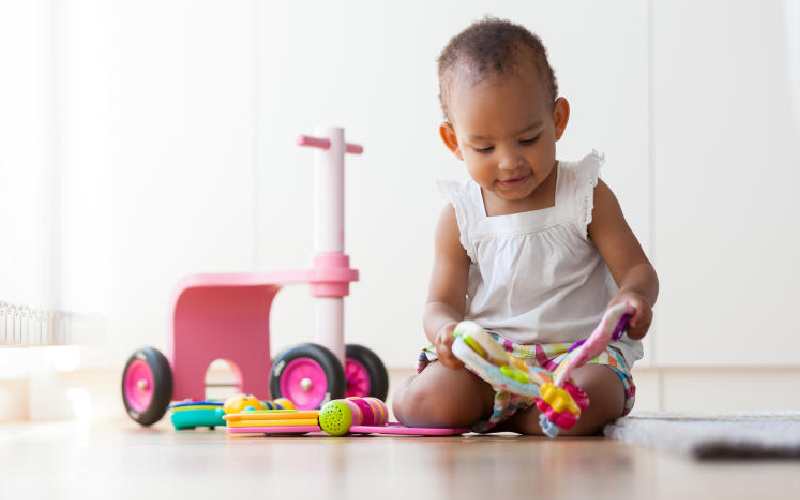
Children are most likely to get into contact with lead when peeling paint off walls or when eating toys. [Courtesy]
Sources of lead poisoning are all around us. They include fuel, paint and batteries. Lead gets into our blood system when we inhale fumes from car exhaust pipes. Children are most likely to get into contact with lead when peeling paint off walls or when eating toys that have batteries containing lead.
Residents of Mombasa County are more exposed to the health hazard. Humid and saline conditions accelerate deterioration of paint, increasing chances of exposure to lead.
According to UNICEF, a third of the world’s children have lead poisoning. Yet adults do not fare any better.
The 3,000 residents of Owino Uhuru slums in Mombasa, for instance, suffered most after a poorly controlled battery recycling facility in their hood exposed them to lead from 2007. Some suffered miscarriages, skin conditions and death, according to a report by Africa Uncensored, which highlighted the plight of one victim, Linet Ouma.
Linet miscarried twice in two years, before succumbing to lead poisoning. Her blood was found to contain 238.3 parts of lead per million, more than 40 times the normal, according to results from the Government Chemist.
The factory smelted car batteries using a special furnace to extract lead for export. The process, a report by the Ministry of Health showed in 2015, emitted fumes, dust, and effluent full of lead particles. The fumes made rain acidic, corroding roofs.
Harvested rainwater had a bitter taste and consumption later led to diarrhoea, stomach ache, among other lead-poisoning related illnesses.
The World Health Organisation (WHO) lists lead among the 10 chemicals of public health concern, besides air pollution, arsenic, asbestos, benzene, cadmium, dioxins, and dioxin-like substances, inadequate or excess fluoride, mercury, and highly hazardous pesticides.
Toys also contribute to lead poisoning in children, according to Immaculate Barasa, a paediatrician at AIC Kijabe Hospital. “When children play with such toys, they may put them in the mouth. The batteries in some of the toys may also have lead, and this increases toxicity.”
Parents should be careful about “what paint they use, the toys they buy for their children and where they buy them from, to avoid exposure to lead toxins,” says Dr Barasa.
She encourages frequent washing of hands after children handle toys, play along painted walls in estates. “Besides batteries, lead is also found in paints as the varnish therein, contain lead that can get into their blood stream through ingestion or inhalation. It can also get in the blood system through the skin and store up in bones and soft tissue.
Peninah Musyoka, a pediatrician at Machakos Children’s Clinic, says lead affects more children than adults, and worse still the bulk of lead poisoning is asymptomatic, meaning one may have it in their blood system without showing, depending on the levels.
Dr Musyoka says children suffering from lead poisoning report to health facilities with gastrointestinal symptoms, anorexia, vomiting, abdominal pains or constipation.
“These symptoms are nonspecific; any child can present these symptoms, which are not necessarily caused by lead poisoning,” she says, adding that high levels of lead toxins lead to convulsions and eventually coma.
Lead affects the neurological system in children. “They may get behavioural abnormalities, hyperactivity, developmental delays and intellectual disability such that they cannot reach their full potential,” she explains.
She said lead affects the blood system, attacking the red blood cells and making their membrane oxidative stress too high, which shortens their life span.
“When red blood cells die earlier than they are supposed to, they can cause hemolytic anaemia. This is a disorder in which red blood cells are destroyed faster than they can be made, and this can be due to environmental hazards such as lead,” says Musyoka.
A third of the world’s children have lead poisoning, according to UNICEF and data from the Institute for Health Metrics and Evaluation. But the situation could be worse, considering Centers for Disease Control and Prevention (CDC) revised its definition of lead poisoning in children: from five micrograms per decilitre of blood to 3.5 micrograms.
Immaculate Barasa, a pediatrician and child environmental health advocate, argues that lowering the threshold is only an action point for public health officials to solve lead toxicity.
“There are no safe levels of lead. Even at very low levels, lead is still present in the blood serum of the vulnerable groups, which include children, pregnant women, and those exposed to lead in their work environment,” she said, adding that the biggest issue with lead is how it is handled.
The Kenya Bureau of Standards began developing standards to regulate lead in paints in December 2015, where Lead Paint Alliance partners agreed on 90 ppm as the total permissive level of lead in paints, varnishes, coatings, and related products.
WHO has also provided guidelines to help clinicians interpret blood lead concentrations, use of gastrointestinal decontamination, nutritional supplements (due to deficiency of certain nutrients like zinc, iron or calcium) and chelating agent, which Barasa says is a very expensive way of management as it is not found in many places.
The best prevention of lead poisoning, she says, is removing victims from the environment to reduce the risk of more exposure.
 The Standard Group Plc is a multi-media organization with investments in media platforms spanning newspaper print
operations, television, radio broadcasting, digital and online services. The Standard Group is recognized as a
leading multi-media house in Kenya with a key influence in matters of national and international interest.
The Standard Group Plc is a multi-media organization with investments in media platforms spanning newspaper print
operations, television, radio broadcasting, digital and online services. The Standard Group is recognized as a
leading multi-media house in Kenya with a key influence in matters of national and international interest.











